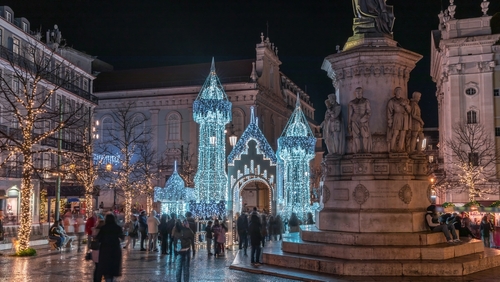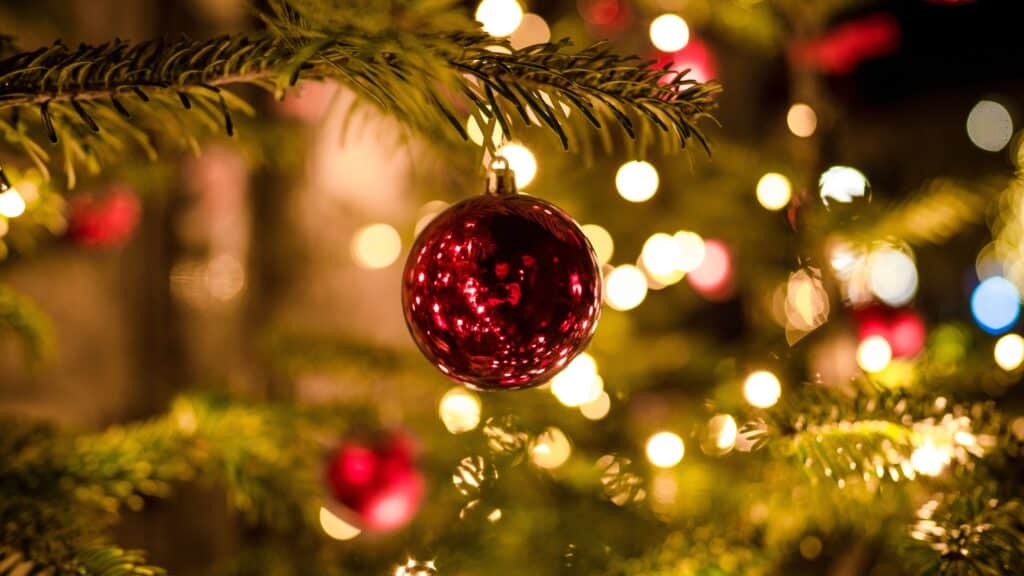The Christmas season in Portugal is a joyous time filled with parties, activities, and delicious meals with friends and family. If you find yourself in Portugal this Christmas, or if you’re hosting friends from Portugal and want to make them feel at home, or you are moving to Portugal and want to celebrate like a local, read our Remitly guide to Portugal Christmas traditions, including customs, foods, and popular holiday activities.
How do you say “Merry Christmas” in Portuguese?
If you want to wish someone a Merry Christmas in Portuguese, use the phrase “Feliz Natal.“ For a more inclusive greeting, you might say “Boas Festas,“ which translates to “Happy Holidays.”
After Christmas Day, holiday greetings in Portugal usually shift to focus on the upcoming year. You may hear people say “Feliz Ano Novo,“ which means “Have a happy New Year,” or “Melhores votos para o Ano Novo,“ which means “Best wishes for the New Year.”
What is the weather like in Portugal at Christmas?
Portugal isn’t known for white Christmases since the location of the country along the Atlantic Ocean gives Portugal a much milder climate than the U.S., Canada, and much of Europe.
In Lisbon, December temperatures typically range from 48.9°F (9.4°C) to 59.5°F (15.3°C). The month brings an average of 14 days of rainfall, amounting to a total of a little less than 5 inches. Water temperatures are usually around 61.9°F (16.6°C), which most people find too cold for swimming.
What is Christmas Eve like in Portugal?
Generally, Christmas Eve, December 24th, is when Portuguese families hold their biggest celebrations. Extended families typically gather under one roof for the night. In the late evening, they eat a large Christmas Eve dinner, and those who are religious may get ready to attend church for Mass. As families come together to share in the festivities, they often reflect on their cultural traditions and values. Similar to Christmas food traditions in Kenya, where meals play a significant role in uniting families, Portuguese dinners are filled with symbolic dishes such as bacalhau and special desserts. This communal atmosphere fosters a sense of belonging and gratitude as they celebrate the joyous occasion together.
Prior to leaving for Mass, families with children make secret last-minute preparations for the night, including laying the figurine of the infant Jesus in the family’s Nativity scene, placing presents for kids under the tree, and filling their shoes with small gifts.
The Portuguese call their Christmas midnight Mass service Missa do Galo, or “Mass of the Rooster,” because it marks the official start of Christmas Day—much like the rooster’s crow signals the arrival of dawn.
Missa do Galo is much like Catholic Mass services in other countries, but Portuguese churches do have one unique tradition. At one point, the priest presents an image of the baby Jesus, and worshippers come to the front of the church to kiss it.
When the family returns home from Midnight Mass, children believe that Pai Natal, or Father Christmas, has visited. Pai Natal closely resembles Santa Claus in North America, including his red, fur-trimmed suit and full white beard. After children discover their Christmas gifts, everyone celebrates the holiday into the early morning hours.
What is Christmas Day like in Portugal?
On Christmas Day, December 25th, families often wake up late and open Christmas presents together. Children may open one or two gifts the night before, but adults usually wait. After unwrapping everything, the family eats lunch together—usually leftovers from the night before.
Typically, December 25 is quieter and more relaxed than Christmas Eve for most families. Loved ones spend the day together watching Christmas movies and socializing. Many people return to their regular work schedule on December 26.
What are some common Portuguese Christmas traditions?
The Portuguese have a number of unique Christmas traditions as well as more common customs that are similar to those in other countries. Let’s explore some common Christmas traditions in Portugal.
Presépios displays
Many families display Presépios, or Nativity scenes, every year and make setting up the figurines part of their holiday traditions. Larger versions also appear outside of homes and in public places.
Adding the baby Jesus figurine in the late evening on Christmas Eve or Day is customary. Some families also add wise men figures on January 6 in honor of Three Kings Day.
Christmas trees
Although Nativity scenes are more common than Christmas trees, many families put up an artificial tree and decorate it much like North Americans do with lights, ornaments, and tinsel.
Christmas Madeiro
In Penamacor, young men cut down the largest tree they can find and use it to create a bonfire in the local churchyard. The community turns out to mingle near the warmth of the fire.
January songs
After Christmas, groups of people will go door-to-door, singing festive carols and playing small instruments. Inviting them inside to enjoy a snack like roasted nuts or figs is customary.
What is a traditional Portuguese Christmas dinner like?
The traditional Christmas dinner in Portugal is called consoada. The meal typically begins with salted cod, boiled potatoes, boiled eggs, and green vegetables. Then, families usually eat a course of more luxurious dishes, like wild meats or shellfish.
Christmas foods popular in Portugal include several tempting desserts, many of which are associated with particular regions.
- Lampreia de Ovos: Egg yolks rolled in sugar and molded into the shape of fish, a popular dessert in the province of Minho
- Rabanadas: Portuguese French toast made by dipping bread in egg and cinnamon sugar, then fried and topped with wine sauce
- Bacalhau: Boiled codfish with cabbage and potatoes
- Arroz dolce: Sweet rice pudding
- Flan: Caramel custard with a layer of caramel sauce on top
- Azevias de grão e amêndoa: Fried pastries made of chickpeas and almonds
- Filhós: A fried dough sprinkled with cinnamon sugar. There are many regional variations; for example, it is customary to add orange or lemon zest in Beira Province, while in Alentejo Province, people often incorporate grated carrots for color and flavor.
- Bolo Rei or King Cake: The most popular of christmas desserts. A fluffy cake filled with dried fruits and nuts. A broad bean and a small gift are baked into the cake. The person who gets the gift is the king or queen of the meal, but the person who finds the bean must buy or make the King’s Cake for next year’s Christmas celebration.
As far as drinks go, porto wine is popular during a holiday celebration. This strong dessert wine originated in Portugal and comes in many varieties. People may also sip Ginjinha, a spirit with a sour cherry flavor, or Amarguinha, an almond liqueur.

What are the best places to spend Christmas in Portugal?
If you’re visiting Portugal at Christmas or spending Christmas in the country as an expat, the following cities are some of the best places to be for the Christmas holidays.
Águeda
Águeda in Central Portugal is well known for its festival of lights. In 2016, the city also became home to the largest Santa Claus in the world. The statue is lit with approximately 250,000 LED lights and is as tall as a seven-story building.
Each year, artists also display new works dedicated to the holiday season as a part of the festivities. Typically, the city also transforms one street into a wintry scene using an umbrella canopy composed of parasols, tinsel, and lights.
Braga
The northwestern city of Braga hosts a festival of lights, but its biggest draw is the live Nativity of Priscos, the world’s largest live Nativity scene. Typically, it includes more than 90 individual scenes that tell the story of the events surrounding the birth of Jesus.
On Christmas Eve, the Casa das Bananas on Rua do Souto in Braga hosts the Bananeiro. In this public event, the community gathers to eat bananas and drink muscatel wine.
Cabeça
Called the Christmas Capital of Portugal, Cabeça in the Serra da Estrela mountains takes Christmas celebrations to the next level. The village is home to just 170 people but manages to create a Christmas village that rivals any found in large Portuguese cities and other cities around the world.
To spread the Christmas cheer, the entire village receives a makeover, transforming the place into a winter wonderland. A Christmas market extends throughout Cabeça, and white Christmas lights twinkle on every building. Kids can enjoy arts and crafts at the Christmas workshop, and local bakeries and restaurants serve up delicious food and drinks.
Guimarães
If you’ll be spending all of the festive season in Portugal, visit Guimarães in the Norte region on November 29. Each year on this date, representatives of the city venture out at dawn to cut down a giant Christmas tree.
Then, thousands of people gather to bring the tree through the town in a grand procession and erect it in the central square. For the rest of the day, the crowd decorates the Christmas tree with Christmas lights and ornaments while Portuguese Christmas music plays.
The annual event honors Saint Nicholas and marks the official start of the festive period in the city.
Lisbon
Portugal’s capital city receives a festive makeover for Christmas each year with light displays in public areas like the Praça do Comércio. The city is also home to numerous Christmas markets. The most well-known is the Campo Pequeno Christmas Market, situated in a former bullfighting arena.
After browsing the nearly 100 stalls, you can grab a bite to eat at the food court and lace your skates for the outdoor ice skating rink. Plus, the Ferris wheel and Santa village make the Wonderland Lisboa market a popular choice for families with kids.
Óbidos
Located in the Estremadura region of western Portugal, Óbidos is home to the Óbidos Vila Natal, one of Portugal’s most famous Christmas markets. A medieval village gives the festivities a fairytale-like feel and makes the Santa Claus village feel very realistic for kids.
In addition to shopping, the festival usually includes numerous live performances, such as puppet shows, circuses, concerts, and magicians.
What are some other Portuguese winter holidays?
In addition to Christmas celebrations, December and January bring a number of other holidays to Portugal, including:
- Restauração da Independência (December 1): Also known as Independence Day, this holiday commemorates when Portugal regained independence after being ruled by Spain from 1580 to 1640.
- Imaculada Conceição (December 8): A public holiday in Portugal, the Feast of the Immaculate Conception remembers when an angel appeared to the Virgin Mary and announced the impending birth of baby Jesus.
- Primeira Oitava (December 26): Boxing Day isn’t a public holiday in most of Portugal, but Madeira is the exception. The tradition dates back centuries, and many families living in the city continue to celebrate Christmas through the 26th as a result.
- New Year’s Eve (December 31): Eating 12 raisins at the stroke of midnight is a common Portuguese tradition, as is raising a glass of champagne to the New Year.
- New Year’s Day (January 1): The first of the year is a public holiday in Portugal and gives people a chance to recover from the previous night’s celebrations and to spend time with friends and family.
- Dia de Reis (January 6): Also called Epiphany or Three Kings Day, this holiday remembers when the wise men came to visit little Jesus in the manger. Some families enjoy king cake on Christmas Eve, but others wait until Dia de Reis.
- Dia do Concelho (Varies): Various municipalities in Portugal have Municipal holidays that correspond to their traditional festivals. Celebrations vary from city to city, but people typically get the day off of work in honor of the observance. Here’s a rundown of the municipal holidays that occur during the winter months:
- Santa Cruz: January 15
- Santa Maria de Feira: January 20
- São Vicente: January 22
- Valença: February 18
FAQs
Christmas Eve, or “Véspera de Natal,” is the main celebration time for Portuguese families. Extended families gather to enjoy a large meal together and attend Missa do Galo (Midnight Mass). Special customs include placing baby Jesus in the family’s Nativity scene and filling children’s shoes with small gifts. After returning from Mass, kids believe that Pai Natal has visited, leaving presents under the tree.
Known as consoada, a Portuguese Christmas dinner starts with the classic dish of salted cod with boiled potatoes, eggs, and greens. Following this, families often enjoy a variety of other luxurious dishes, like shellfish or wild game, along with traditional desserts that vary by region, making for a festive and hearty meal.


